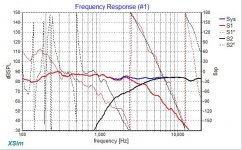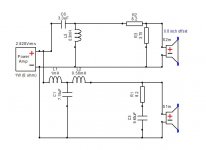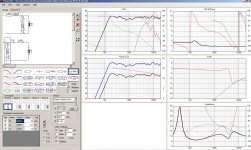Very interesting project and well-executed.
The JX150 was never intended as a full-range driver. Both the original JX125 and JX150 were intended to support to support the JX53 mid-treble unit with an ideal crossover point at 500Hz (1st order). The extension beyond that point was to ensure a smooth crossover to the smaller unit given the use of a 1st order crossover.
The JX150 was never intended as a full-range driver. Both the original JX125 and JX150 were intended to support to support the JX53 mid-treble unit with an ideal crossover point at 500Hz (1st order). The extension beyond that point was to ensure a smooth crossover to the smaller unit given the use of a 1st order crossover.
It would be interesting to see the waterfall plot for the JX150NG but the only datasheet for this unit which shows one appears to have the jx125 plot, or at least it's labelled that way.
The JX150NG was produced under licence by EAD in Indonesia so we didn’t publish a set of graphs on the EJJ site. EAD should have those.
Nice design! Good to see more Jordan derived drivers on this site. Wasnt long ago when it was some kind of heresy to mention Jordan
Mike
I might try your suggestion using wire, particularly as I always find the values I settle on are never standard ones due to finding I have to adjust the treble to within 1/8dB until I get the balance that blends nicely.
In that case these links may help you:
manganin resistivity - Google Search
Round Wire Resistance Calculator
mike
Following further listening with one or two recordings showing signs of being slightly 'shouty' at certain points on voice or trumpet I looked at the Xover again and reduced the midrange by 0.75dB or so by adding a few turns to the first inductor. I also realised I hadn't applied mic calibration to the woofer section. Its effects are mainly above 5kHz but it does make a slight difference/improvement to the woofer roll-off. The low pass roll-off slope now looks better and the occasional slight problem on those particular recordings has gone. Phase tracking through Xover is also marginally improved🙂
Having lived with these speakers for a few weeks now I'm very pleased how little final voicing has been necessary...which no doubt highlights the importance of simulating from real measurements.
I'm considering air cored inductors but when I calculate the massive increase in wire length needed for these I have second thoughts. Years ago in an external Xover I switched many times between cored and air cored inductors (1.75mH if memory serves) and through listening comparisons formed a clear preference for superior clarity of the cored, however with smaller inductors this time perhaps the results could be different.
Attachments:-
Response v1.1(before) and v1.2(after)
Crossover schematic
Having lived with these speakers for a few weeks now I'm very pleased how little final voicing has been necessary...which no doubt highlights the importance of simulating from real measurements.
I'm considering air cored inductors but when I calculate the massive increase in wire length needed for these I have second thoughts. Years ago in an external Xover I switched many times between cored and air cored inductors (1.75mH if memory serves) and through listening comparisons formed a clear preference for superior clarity of the cored, however with smaller inductors this time perhaps the results could be different.
Attachments:-
Response v1.1(before) and v1.2(after)
Crossover schematic
Attachments
Last edited:
I'm building a surround system and found this interesting since we're going in similar directions. I went for the JX125NG with Hi-Vi RTC1-A ribbons. One suggestion I can make is that the impedance and phase curves could be flattened with a suitable network, otherwise it looks awesome to me. Since I've worked on electrostatic design your description of them sounding like the Quads is encouraging although I was expecting good things anyhow, having owned and/or heard many Jordans before.
Last edited:
Are your frequency response measurements exported from Holm without smoothing? Looks like you have a lot of reflections/room effects in there. If so, try using the 'complex smoothing' function in HolmImpulse before exporting as it implements variable width windowing which will reject late reflections.
After exporting to .frd the impulse response data is lost, so any smoothing applied in Xsim will only visually smooth reflection effects rather than reject them.
After exporting to .frd the impulse response data is lost, so any smoothing applied in Xsim will only visually smooth reflection effects rather than reject them.
Haiku
Thanks for the suggestion. I might look at that again at some point but I was keeping half an eye on impedance phase too. One or two of my earlier Xover circuits had flatter impedance curves but compromised other design considerations which were important to me in this design.
Good luck with your project
Thanks for the suggestion. I might look at that again at some point but I was keeping half an eye on impedance phase too. One or two of my earlier Xover circuits had flatter impedance curves but compromised other design considerations which were important to me in this design.
Good luck with your project
Last edited:
Following further listening with one or two recordings showing signs of being slightly 'shouty' at certain points on voice or trumpet I looked at the Xover again and reduced the midrange by 0.75dB....
We now see what you like. Turns out, what you like is +6dB in the bass relative to the tweeter.
Why waste time fussing with the crossover elements when tuning follows listening?
B.
Last edited:
I assume that's rhetorical but I'll answer.
Who knows why, but apparently most of us find a falling response more listenable than one which measures flat and I'm no exception. This design sounds neutral to my ears.
Regarding simulation vs tuning by ear, why not use both. As a professional musician for 30 years (with absolute pitch) and DIY audio hobbyist for even longer these ears ain't bad. Measurements and simulations save time.
Who knows why, but apparently most of us find a falling response more listenable than one which measures flat and I'm no exception. This design sounds neutral to my ears.
Regarding simulation vs tuning by ear, why not use both. As a professional musician for 30 years (with absolute pitch) and DIY audio hobbyist for even longer these ears ain't bad. Measurements and simulations save time.
I assume that's meant to be self-evident, but I'll answer.I assume that's rhetorical but I'll answer.
Regarding simulation vs tuning by ear, why not use both.
First of all, most everybody likes the rising bass. Might be nothing but Fletcher-Munson; but if you went house to house, you'd find it so. Ain't no way to explain that to your crossover sim.
Funny thing, manufacturers don't necessarily use the "self-evident" method for passive crossover intact-box products. They (or anybody) can start with calculations easily done on a piece of scrap paper or in your head easily. If you can remember the numbers "6.3" and "160" you need nothing more*. But then add crossover elements suggested by listening tests, up to maybe 18 in some of the fancy little boxes.
And with DSP, waste of time entirely. You just note in your head how low the tweeter can go and survive jolts. Then you run low loudness FRs. Then you decide on that basis (and on a few important other criteria too), how you'd like to divide up the spectrum. Listen and measure, possibly around the room a bit. Iterate in 15 seconds. Listen and measure next day......
B.
*and you shouldn't be making crossovers unless you know where 6.3 and 160 come from.
Last edited:
I was unable to get anything resembling a smooth roll-off with less than 3rd order.
Sure, it's a typical metal driver and the heavy breakups above 5 kHz need to be attenuated sufficiently.
BTW, according to a review in HOBBY HiFi the waterfall plot of the JX150NG is clean up to 5 kHz. The following resonances at 5.5, 6.9 and 8 kHz are bad and do decay slowly.
I want to thank bentoronto: from now on I am going to look at 1/1 octave smoothing to double check. When I look at 1/24 or 1/12 smoothing I clearly have mental bias deceiving myself as to what looks "flat". The overall tonal balance is crystal clear with full octave or 1/3 octave smoothing.
Haiku
Thanks for the suggestion. I might look at that again at some point but I was keeping half an eye on impedance phase too. One or two of my earlier Xover circuits had flatter impedance curves but compromised other design considerations which were important to me in this design.
Good luck with your project
Thanks.
Here are the simulated charts and crossover network. The components inside the box remedy most of the lumpiness in impedance and phase. You might think this will sound bright but 15 degrees off axis it should drop at high frequencies. I may do something about the bass resonant peak if I decide to current drive them, but that would need to come after actual measurements.
Attachments
Last edited:
Dissi
Thank you for mentioning the Hobby hifi review. Frustratingly I can't find a copy of it online as it would be an interesting read. It's a shame EAD haven't included it in their product details as they have for the JX92.
Tim
Thank you for mentioning the Hobby hifi review. Frustratingly I can't find a copy of it online as it would be an interesting read. It's a shame EAD haven't included it in their product details as they have for the JX92.
Tim
Haiqu
Nice FR within +/-2dB. The bass filter response looks curious to me though where it turns up at 6kHz, unless I'm missing something. Just a thought but wondering if you've tried a 3rd order on the bass which might improve phase tracking and supress the breakup peaks?
Nice FR within +/-2dB. The bass filter response looks curious to me though where it turns up at 6kHz, unless I'm missing something. Just a thought but wondering if you've tried a 3rd order on the bass which might improve phase tracking and supress the breakup peaks?
As mentioned earlier, the original JX150 was only intended to operate up to 500Hz. EAD made the decision to try and push it as a wider-range drive unit.
The same was true of the JX125 although, again, some manufacturers chose to use it as a bass-mid unit, e.g. Townshend with their Glastonbury design. I heard this arrangement and thought it didn't match the JX125 when used as intended.
The same was true of the JX125 although, again, some manufacturers chose to use it as a bass-mid unit, e.g. Townshend with their Glastonbury design. I heard this arrangement and thought it didn't match the JX125 when used as intended.
TimA: The crossover is designed to kill a really nasty peak at 6kHz and was the simplest design that could achieve that.
Colin: Hi mate! Rob from Brisbane here, I've been emailing you about the Aztec driver restorations. Yes, quite aware of the limitations of these drivers. But when they're on special at 738 SEK (about 63 quid a piece) you tend to overlook this. 🙂 And BTW having owned and used the original 50mm drivers, I wouldn't use their successor - the JX53 - as low as 500Hz. Maybe 1000. So first order was always out of the question.
My original design for the 50mm drivers used an Altec 411-8A 15" bass driver crossing over to a pair of 50mm Jordans at around 1200Hz. Bi-amped. In 1977. Had the Jordans mounted in a piece of 4" PVC drainpipe on a wooden cradle mount so that they could be rotated in the vertical plane. They sounded best at 45 degrees, bouncing off the 10' ceilings in my art deco Bondi flat. I was most disappointed that they couldn't be used lower, the Altecs sound very woolly at 1200Hz.
The Towshend Glastonbury uses yet another variant of the Jordan Aztec design, not the JX125. Completely different frame.
Colin: Hi mate! Rob from Brisbane here, I've been emailing you about the Aztec driver restorations. Yes, quite aware of the limitations of these drivers. But when they're on special at 738 SEK (about 63 quid a piece) you tend to overlook this. 🙂 And BTW having owned and used the original 50mm drivers, I wouldn't use their successor - the JX53 - as low as 500Hz. Maybe 1000. So first order was always out of the question.
My original design for the 50mm drivers used an Altec 411-8A 15" bass driver crossing over to a pair of 50mm Jordans at around 1200Hz. Bi-amped. In 1977. Had the Jordans mounted in a piece of 4" PVC drainpipe on a wooden cradle mount so that they could be rotated in the vertical plane. They sounded best at 45 degrees, bouncing off the 10' ceilings in my art deco Bondi flat. I was most disappointed that they couldn't be used lower, the Altecs sound very woolly at 1200Hz.
The Towshend Glastonbury uses yet another variant of the Jordan Aztec design, not the JX125. Completely different frame.
Last edited:
- Home
- Loudspeakers
- Multi-Way
- New Jordan JX150/A.C.Ribbon Design



